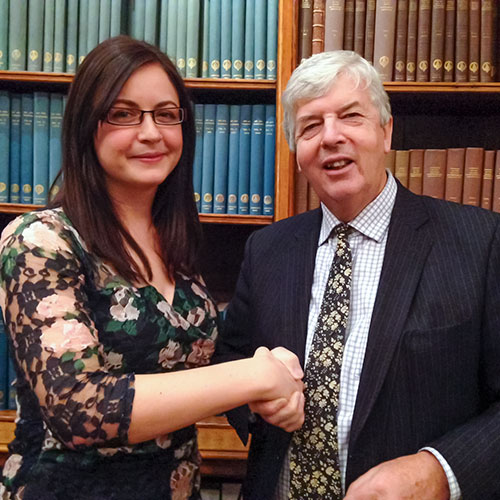
Andrew Taylor of the Science and Technology Facilities Council congratulates Louise Mayor on winning the European Astronomy Journalism Prize 2014. (Courtesy: ESO/STFC)
By Matin Durrani
If you think that writing a great feature article about physics is easy, think again. You want something that’s pitched at the right level for the audience. You’ve got to avoid jargon and explain technical terms where necessary. You can’t go on and on – you’re not trying to rewrite Wikipedia.
Most importantly, you need to tell a good story and say something new, different and intriguing. And remember, your readers could switch off at any point, so the article has to be well written, flow well from point to point, have plenty of colour and, ideally, have some pay-off or punch-line at the end. No point just trailing off into nothingness. Oh, and good pictures, headlines and captions are a must.
So I’m sure you’ll join me in congratulating my colleague Louise Mayor – features editor of Physics World magazine – who has won this year’s European Astronomy Journalism Prize for an article she wrote for the October 2014 edition of the magazine. Her winning article is entitled “Hunting gravitational waves using pulsars” and looks at efforts to detect gravitational waves using radio telescopes to observe distant pulsars.
“I first heard about this method last year and was so curious about how it worked that I felt compelled to find out more by visiting the Jodrell Bank Observatory and then to share the story with others,” says Louise.
Run by the Science and Technology Facilities Council (STFC) and the European Southern Observatory (ESO), in conjunction with the Association of British Science Writers and the Royal Astronomical Society, the aim of the competition is to “celebrate the outstanding coverage of astronomy and in particular work that enthuses the audience of the importance of astronomy”.
This is the third year the award has been running and Louise has won a fantastic prize – a trip to ESO’s Atacama Large Millimetre Array (ALMA) facility in Chile. Located 5000 m above sea level in the Atacama Desert, it consists of some 50 antennae each of 12 m diameter plus a compact array of 16 antennae is starting to let astronomers see and image the enigmatic cold regions of the universe.
Two other articles were highly commended: “Life in the solar system” by Colin Stuart in All About Space magazine and “India bets on its astronomers” by Emile Martin – a section editor at Ciel & Espace.
I can exclusively reveal that Louise is now in high-level discussions with the STFC and ESO about when to start packing her bags for South America. “I can’t wait to visit ALMA,” she says. “I’ll be able to gaze up at a night sky full of more stars than I’ve ever seen before, experience the weird effects of high altitude and find out what cosmic questions the scientists there are trying to answer.”
Plus gather plenty of material for lots more top-notch physics features, I hope!
A reasonable writeup. However, one has to know that to produce the gravitational waves, the source has to undergo quadrupole-deformation vibrations un like the dipole ones for the EM radiation. Finally, as mentioned in the text, gravity is not the the longest ranged of the four fundamental forces, the EM has the same range, because both of the photons and the gravitons have zero rest mass.
Well done Louise. I have a special interest in this topic because like the Michelson-Morley experiment, LIGO is an interferometer, and there’s a worry that there’s a rubber-ruler problem.
Trackback: Physics Viewpoint | Louise Mayor bags European astronomy journalism prize
Trackback: Blog - physicsworld.com
Trackback: Blog - physicsworld.com
Trackback: Blog - physicsworld.com
Trackback: Time to claim the Chilean prize – MyPhysNet